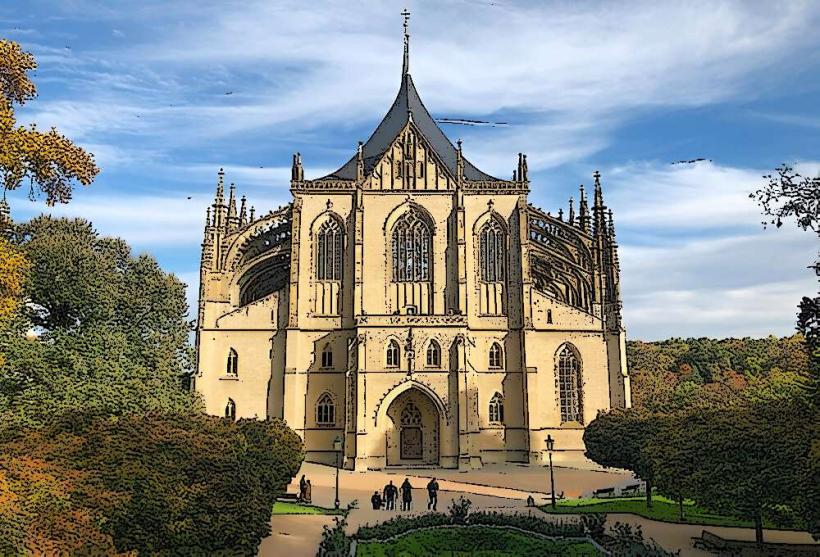Information
Landmark: Szent István CathedralCity: Tatabanya
Country: Hungary
Continent: Europe
The Szent István Cathedral (St. Stephen's Cathedral) is a significant Roman Catholic church located in the city of Székesfehérvár, Hungary. It is one of the most important landmarks in the city and a prominent example of Hungarian ecclesiastical architecture. The cathedral is dedicated to St. Stephen, the first King of Hungary, and is a key site of religious, historical, and cultural importance in the region.
Location and Overview
- The Szent István Cathedral is located in the city center of Székesfehérvár, which is in central Hungary, approximately 65 kilometers southwest of Budapest.
- The cathedral is situated on a prominent site, and it stands as a defining feature of the city's skyline, visible from various points in Székesfehérvár.
Historical Background
- The original St. Stephen’s Cathedral was founded in 1019 by King Stephen I (Szent István), the first Christian king of Hungary. He established the cathedral as part of the early Christianization of Hungary.
- St. Stephen's was initially built as a Romanesque church, but over the centuries, it has undergone various expansions and renovations, blending Romanesque, Gothic, and Baroque architectural elements.
- The cathedral was largely rebuilt between 1774 and 1809, following the destruction of much of the earlier structure. This reconstruction led to the present Neoclassical style of the cathedral that visitors see today.
Architecture
- The current cathedral is designed in a Neoclassical style, with a large dome and twin bell towers that define its exterior appearance.
- The cathedral’s interior is richly adorned, with Baroque and Rococo elements, including an altar, frescoes, and a series of stained-glass windows that depict biblical scenes.
- The interior is spacious, featuring a large nave with side aisles and a grand main altar. The cathedral also includes chapels and crypts, many of which are dedicated to saints and royal figures.
- The organ inside the cathedral is another significant feature, and it is still used for church services and concerts.
Religious and Cultural Significance
- St. Stephen’s Cathedral holds great religious significance as a place of worship and pilgrimage. It is dedicated to St. Stephen, the patron saint of Hungary, and it serves as a diocesan cathedral for the Roman Catholic Diocese of Székesfehérvár.
- It is also historically important as the site where Hungarian kings were once crowned and where St. Stephen’s remains were kept for centuries after his death. Székesfehérvár was the traditional coronation city for Hungarian kings.
- The cathedral is a site for important religious ceremonies, including annual Feast of St. Stephen celebrations, which are particularly significant in Hungarian religious life.
Key Features and Attractions
The Dome: The dome of the cathedral is one of its most prominent architectural features, visible from a great distance. Visitors can see the vast expanse of the dome’s interior when they enter the church, contributing to the grandeur of the space.
Main Altar: The main altar is richly decorated in Baroque style, and it is the focal point of the cathedral’s interior. It contains a portrait of St. Stephen and other religious iconography.
Stained-Glass Windows: The cathedral’s stained-glass windows are a significant feature of the interior, depicting scenes from the life of St. Stephen and various biblical stories. These colorful windows add a sense of light and vibrancy to the space.
Organ: The pipe organ inside the cathedral is a major feature of its interior, and it is still used for church services as well as concerts. It is a symbol of the cathedral's musical and cultural heritage.
Crypts and Chapels: The cathedral has several crypts and chapels. Notably, the Royal Crypt was the burial site for many Hungarian monarchs during the medieval period, making it an important historical feature of the cathedral.
Significance in Hungarian History
- St. Stephen’s Cathedral was one of the key centers of Christianity in Hungary during the Middle Ages. It is often associated with the foundation of the Hungarian Kingdom and the establishment of Christianity as the state religion under King Stephen I.
- For centuries, the cathedral served as the site for coronations of Hungarian kings, and it held great importance in the religious and political life of the kingdom.
- The cathedral’s crypts once contained the remains of Hungarian kings, including St. Stephen, and the city of Székesfehérvár itself was the royal seat of Hungary until the 13th century. The connection between the cathedral and the monarchy is a key aspect of its historical significance.
Restoration and Modern-Day Use
- St. Stephen's Cathedral has undergone significant restoration work over the years, especially after the damage caused during World War II and during other periods of upheaval.
- Today, the cathedral continues to be an active place of worship, and it also functions as a major cultural venue, hosting concerts, musical events, and religious celebrations. It is a popular destination for tourists, religious pilgrims, and those interested in Hungarian history and architecture.
Visiting the Cathedral
- Opening Hours: The cathedral is typically open for visitors throughout the day, with services held regularly. It is a good idea to check in advance for any special events or ceremonies that might affect visitor access.
- Admission: Admission to the cathedral is often free, though donations are encouraged to help with maintenance and restoration efforts. There may be a small fee for visiting certain areas or participating in guided tours.
- Nearby Attractions: Visitors to Székesfehérvár can explore other nearby historical and cultural sites, including the City Hall, the Bory Castle, and the Museum of the History of the Hungarian Kingdom.
Conclusion
The Szent István Cathedral in Székesfehérvár is a stunning example of Hungarian ecclesiastical architecture and a symbol of the country’s Christian heritage. With its rich history, magnificent architecture, and cultural significance, it remains one of Hungary’s most important religious and historical sites. Whether you're interested in its religious importance, historical connection to the monarchy, or artistic beauty, the cathedral offers a fascinating glimpse into Hungary’s past and present.





